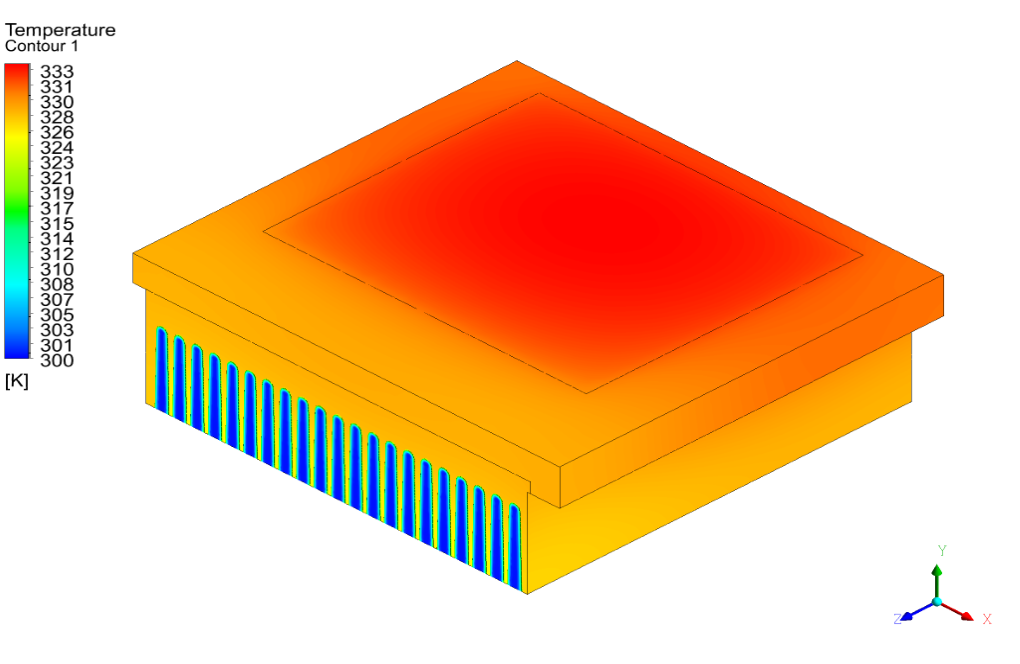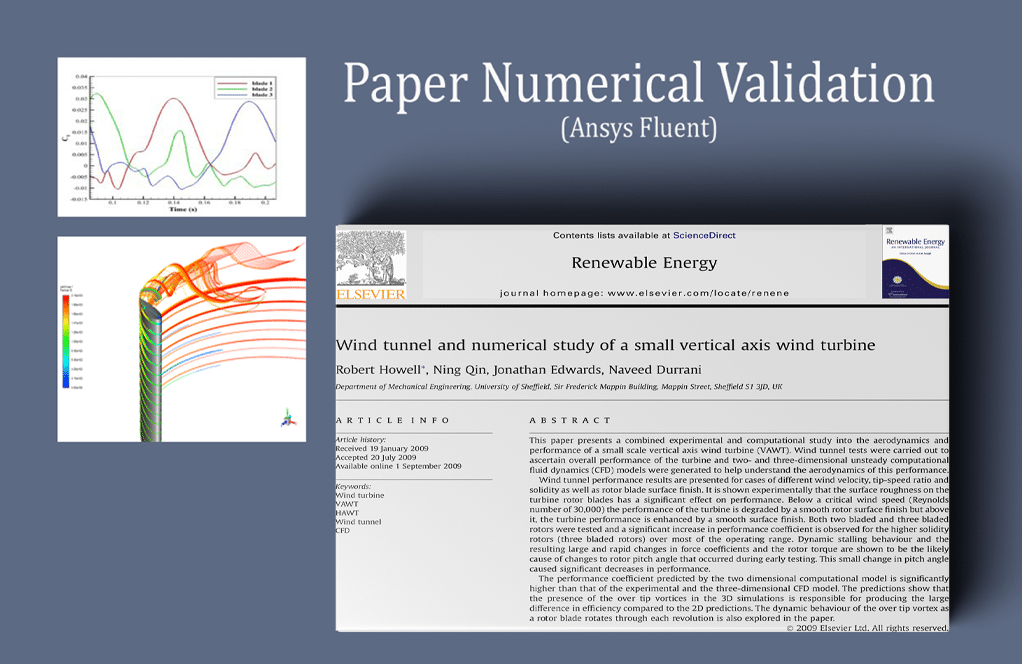IGBT Heat Sink Cooling CFD Simulation, ANSYS Fluent Training
$80.00 Student Discount
- The problem numerically simulates the cooling of an IGBT heat sink using ANSYS Fluent software.
- We design the 3-D model with the Gambit software.
- We Mesh the model by Gambit software, and the element number equals 11872367.
- The Energy Equation is activated to apply the cooling process.
To Order Your Project or benefit from a CFD consultation, contact our experts via email ([email protected]), online support tab, or WhatsApp at +44 7443 197273.
There are some Free Products to check our service quality.
If you want the training video in another language instead of English, ask it via [email protected] after you buy the product.
Description
Description
In this project, the Cooling of an IGBT Heat Sink is simulated by ANSYS Fluent software. We perform this CFD project and investigate it by CFD analysis.
An insulated-gate bipolar transistor (IGBT) is a three-terminal power semiconductor device primarily used as an electronic switch. An IGBT generates significant heat and can be affected by excess thermal energy.
Using air cooling or liquid cooling techniques, e.g. heat sinks, this excessive heat can be removed, which can lead to improved performances, thus enabling much higher power densities and more compact modules.
The heat sink is in contact with a heat source (with the heat flux of 14583 W/m2) on one side and the air flows on the other side with a mass flow of 0.25Kg/s. The airflow is responsible for cooling the heat sink.
The geometry for analyzing this simulation consists of a heat source and a heat sink. The geometry is designed and meshed in Gambit®.
The mesh type used for this geometry is unstructured and the element number is 11872367.
IGBT Methodology
The Energy Equation is activated to analyze the heat transfer rate and the Laminar viscous model is activated to solve the airflow.
IGBT Conclusion
At the end of the solution, we present contours of temperature, velocity, surface heat flux, and Nu number. The contours show that the cold flow of the fluid has been able to lower the temperature of the heatsink.
In fact, in the temperature exchange caused by the cold flow of fluid and heat source, the temperature of the whole set has dropped and the purpose of this project has been met.









Vicky Schuster –
The detailed visualization of the results greatly aids in understanding the cooling performance of the heat sink.
Ms. Francesca Becker DDS –
This simulation is an effective tool for optimizing the design of heat sinks in IGBT modules.
Miss Emmanuelle Thompson I –
This simulation is a groundbreaking development in the field of IGBT module cooling optimization!
Jerald Hickle –
I’m amazed by the level of detail in the IGBT Heat Sink cooling simulation project! The contours of temperature and fluid flow really helped me visualize the effectiveness of the heat sink design. Great training material!
MR CFD Support –
Thank you for your feedback! We’re thrilled to know that our training material helped you understand the cooling process and effectiveness of the heat sink design. Your appreciation encourages us to consistently provide high-quality and detailed simulations. Looking forward to offering more value in your future learning endeavors!
Dr. Pedro Pfannerstill –
I’m really impressed by the way this simulation manages to accurately depict the cooling process of an IGBT Heat Sink. The temperature drop achieved by this airflow must be critical for devices that generate a lot of thermal energy. It’s great to see that the goal of the project has been met effectively!
MR CFD Support –
Thank you so much for your kind words and for noting the effectiveness of the IGBT Heat Sink cooling simulation. Indeed, cooling mechanisms like these are crucial for maintaining the optimal performance of high-power devices. We’re delighted to hear that you’re satisfied with the results and found our CFD analysis insightful.
Jaron Berge –
MR-CFD, Which software is used in CFD Simulation?
MR CFD Support –
I’m using ANSYS Fluent software.
Fermin Leffler –
The analysis of the IGBT heat sink cooling simulation really demonstrates the effectiveness of cooling strategies in managing heat for power semiconductor devices. The detailed results, including temperature and airflow contours, effectively convey the cooling process and confirm the success of the design. Well done to the MR CFD team for providing such an insightful training resource!
MR CFD Support –
Thank you for your positive feedback! We are thrilled to hear that you found the IGBT heat sink cooling simulation training insightful and effective in demonstrating modern cooling strategies for power semiconductor devices. Your appreciation means a lot to us and motivates us to keep providing high-quality CFD training resources. If there’s anything more you’re interested in learning or exploring, please don’t hesitate to reach out. Thanks again for choosing MR CFD!
Jaeden Conroy –
I just completed my own simulation project following this training for an IGBT Heat Sink design and it worked flawlessly. Impressed with the clear and thorough explanations in every step of the course making the complex CFD concepts understandable. Kudos to the MR CFD team!
MR CFD Support –
Thank you for your wonderful feedback! We’re thrilled to hear that our training was helpful and met your expectations. Your success with the IGBT Heat Sink simulation project is exciting for us, and we appreciate the time you took to complement our product. We strive to maintain clarity and thoroughness in all our materials. Looking forward to supporting your future CFD adventures!
Misael Hermiston –
This simulation is a fantastic resource for understanding the cooling performance of heat sinks in IGBT modules!
Donnie Olson –
This review is so insightful! Great to hear that the simulation effectively demonstrates the cooling of an IGBT Heat Sink!
MR CFD Support –
Thank you for your kind words! We’re thrilled to know that you found the simulation and the results valuable and insightful. Ensuring that the complex heat transfer and fluid dynamics are accurately represented is crucial, and we’re glad this was reflected in the project. If you have any more feedback or need further clarity, please don’t hesitate to reach out.
Manuela O’Reilly –
I have a question, Can this simulation be used to optimize the design of heat sinks in IGBT modules?
MR CFD Support –
Absolutely! The insights gained from this simulation into the heat dissipation and airflow around the heat sink can be instrumental in optimizing the design of heat sinks.
Hobart Kunde –
Fantastic product! The results were exactly as portrayed in the training, and it’s clear how efficient this simulation is for heat sink designs.
MR CFD Support –
Thank you for your splendid review! We’re thrilled to hear the IGBT Heat Sink Cooling simulation met your expectations. If you need further assistance or have another project in mind, feel free to reach out to us.
Dr. Erna Harris Sr. –
The level of detail in the temperature, velocity, surface heat flux, and Nu number contours was extremely beneficial for understanding the cooling process. Great job!
MR CFD Support –
Thank you for your positive feedback! We’re glad to hear that the contours provided were informative and useful for understanding the heat sink cooling process. If you have any more questions or need further clarifications, please let us know.
Anastasia Predovic –
I’m impressed with how detailed the contours of temperature and velocity are in this simulation. Understanding heat flux and Nu number distributions are so beneficial for improving thermal management.
MR CFD Support –
Thank you for your feedback! We are thrilled to hear that the detail in the temperature and velocity contours of the IGBT Heat Sink Cooling simulation was useful to you. Accurate thermal management is vital for the performance and reliability of electronic components, and we strive to provide comprehensive analysis to meet such needs. We appreciate your appreciation of our efforts!
Haven Mitchell IV –
I’m very impressed with the details provided in the IGBT Heat Sink CFD simulation, especially the comprehensive analysis presented at the end. The information regarding the model, such as using a laminar flow model and activating the energy equation, confers substantial insight into the specifics of thermal management in electronics. Understanding the practical importance of cooling semiconductors for enhanced performance was enlightening!
MR CFD Support –
Thank you for your positive feedback! We are delighted to hear that you found the IGBT Heat Sink Cooling CFD Simulation comprehensive and informative. We strive to provide clear and in-depth information to aid in understanding and applying the principles of CFD in practical scenarios. We appreciate your acknowledgment of the effort put into presenting the results and analysis. Your enthusiasm for the content is greatly appreciated!
Dr. Flo Davis –
I just finished going through the IGBT Heat Sink Cooling CFD Simulation training with ANSYS Fluent. The level of detail in the tutorial was incredible. From the initial setup to the interpretation of the results – everything was presented very clearly. Watching the temperature and velocity contours evolve as the solution progressed was especially insightful.
MR CFD Support –
We are thrilled to hear that our training material on the IGBT Heat Sink Cooling CFD Simulation was helpful and insightful for you. We always strive to provide our customers with high-quality and detailed tutorials for a better learning experience. Thank you for taking the time to share your positive feedback!
Carmelo Schowalter –
The training for the IGBT Heat Sink Cooling simulation was detailed and practical. It helped me understand airflow simulations and their impact on cooling performance. The comprehensive step-by-step guide and available troubleshooting tips were particularly useful. Great work!
MR CFD Support –
Thank you so much for taking the time to provide feedback on our IGBT Heat Sink Cooling CFD Simulation training. We are thrilled to hear that it has been helpful and informative for you! Your satisfaction is very important to us, and we aim to provide high-quality detailed training materials to all our clients. Please don’t hesitate to contact us if you need further assistance. Regards, MR CFD Support Team.
Kathryn Mitchell –
Fantastic training on the IGBT Heat Sink Cooling simulation! The detailed explanation of the methodologies like the energy equation and laminar flow model, along with the reported outcomes, made this a very enriching learning experience. Seeing the temperature contours changing was especially insightful.
MR CFD Support –
Thank you for your warm feedback! It’s great to hear that the training material for the IGBT Heat Sink Cooling simulation was helpful and provided clear insights into the temperature management. We’re pleased to know the methodologies and results were well-explained and contributed to your learning experience!